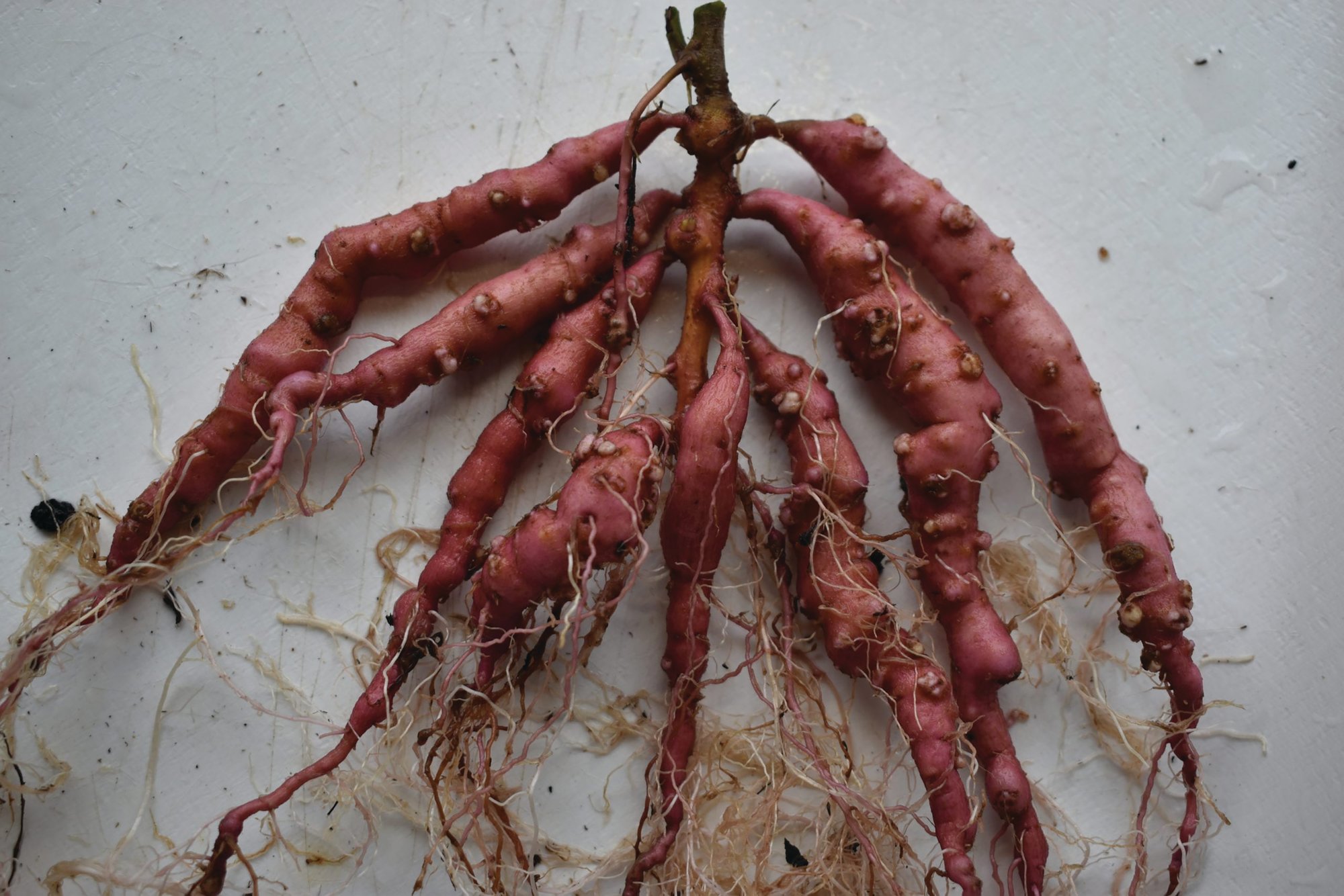Farmers, gardeners can help root out a new aggressive nematode
BY CLEMSON UNIVERSITY COLLEGE OF AGRICULTURE, FORESTRY AND LIFE SCIENCES
How can you help stop a plant pest? As they check their fields and gardens this summer, growers are the first line of defense in preventing the spread of a microscopic worm threatening vegetable crops in the Southeast, including sweet potatoes.
The guava root-knot nematode - Meloidogyne enterolobii or M.e. for short - spreads aggressively and causes more severe damage than other nematode species, says Paula Agudelo, a Clemson University expert on plant diseases and their management. M.e. causes abnormal root growth, creating galls on root crops such as sweet potatoes, and it can infect many other crops, including watermelon, tomato, pepper, carrot, squash, cucumber, soybean, cotton and tobacco.
"M.e. can cause big crop losses and pose a risk to exports," Agudelo says. "It is critical for commercial growers and home gardeners to learn what M.e. looks like so that they can prevent and manage the problem."
M.e. has been found in 13 counties in North Carolina and one in South Carolina since 2019, triggering quarantines and regulations on out-of-state shipments of sweet potato seed and slips. South Carolina, Florida and Puerto Rico have confirmed cases, and monitoring is underway in Louisiana and Georgia, though it hasn't been found there yet.
FINDMe (Focusing Investigations on the Distribution and Management of Meloidogyne enterolobii) is a research program dedicated to reducing the vulnerability of growers to M.e. Housed at Clemson University and funded by the USDA, the team of scientists from Florida, North Carolina, South Carolina and Georgia, growers, extension agents and industry leaders are taking a 5-prong approach focused on the distribution, resistance, management, economics and education in relation to M.e.
At present, researchers are investigating sources of M.e. resistance, developing M.e. resistant germplasm and evaluating management strategies while simultaneously educating the farming community about the nematode's risks.
It is critical for commercial growers and home gardeners to learn what M.e. looks like so that they can both prevent and manage the infestation.
The most notable symptom is called galling (seen in above photo), which presents as clumps of knots in the plant's roots, or sometimes on the surface of underground structures in crops such as sweetpotato, white potato and carrot. While the most visual symptom of M.e. is best seen on the root, leaf chlorosis (yellowing), wilting, poor growth, poor stands and low yield may also be visible above ground.
FINDMe guidelines to prevent and manage M.e
The seriousness of this infestation should not be taken lightly. Once established in a field, it is nearly impossible to eradicate the nematode, and long-term management strategies are costly. Thus, FINDMe advocates for a strong prevention strategy. Their expertise offers guidelines for both commercial growers and home gardeners.
For commercial growers
FINDMe recommends that commercial growers have their fields regularly sampled for nematodes and actively monitor crops for symptoms, particularly root galling. Should symptoms be present, farmers should have a M.e. molecular DNA test performed.
Infested soil is one of the greatest risks to spreading M.e. Farmers should be cautious not to move infested soil into other fields, carefully washing all equipment, tools and clothing that may have come into contact with the nematode. Given the current threat to sweet potato in the region, only certified seed and slips should be used. Prior to planting sweet potato or any other transplanted crop, all seeds and slips should be inspected for galling and bumps.
"The yield losses in the second crop may be more severe than in the first crop," says John Mueller, co-PI of FINDMe and professor of plant pathology at Clemson University. "Low early season soil temperatures and large root systems on transplants may allow the first crop to produce a reasonable yield. Extensive galling and nematode reproduction may occur towards harvest."
"These high populations of nematodes can be very damaging to the fall crop, especially if seeded rather than transplanted," Mueller adds.
If M.e. is found in a commercial field, a long-term management strategy must be initiated. Adrienne Gorny, FINDMe co-PI and assistant professor of nematode epidemiology and management at North Carolina State University, adds, "We suggest a 3-year period of rotating with non-host crops, including corn, peanut, sorghum and small grains. Other management activities including spring fumigation and nematicide application, improved soil health, crop monitoring for damage, and risk assessments for future crops are highly recommended."
For home gardeners
Homeowners must also recognize the danger that M.e. can cause in their own gardens. Prevention is the best management, and thus it is vital for gardeners to purchase all seed, slips and soil from reputable sources. Roots of all transplanted plants should be inspected for galls, and if any symptoms are found, plants can be sent to a local plant disease diagnosis clinic for testing.
In the case that M.e. is found, the homeowner must not move any infested soil or roots. "We recommend either planting non-host crops such as turf grass, corn or peanut in the infested location for 2-3 years, or alternatively, covering the site with mulch for 1-2 years," adds FINDMe co-PI Johan Desaeger, assistant professor of entomology and nematology at University of Florida's Gulf Coast Research and Education Center.
In the meantime, gardeners should add organic matter in order to maintain the health of microbiome and roots, and actively keep their gardens weed free. They can also consider removing all plant material and solarizing garden beds.
Farmers and gardeners are encouraged to contact their local county extension agent, the U.S. Department of Agriculture or a FINDMe university specialist with any questions. More information on M.e. prevention and management for commercial growers and home gardeners can be found at www.findmenematode.org; email findmenematode@gmail.com; or @FINDMeNematode.
More Articles to Read

